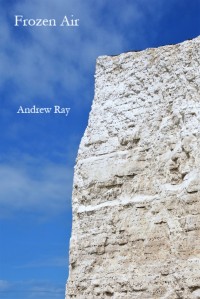Postcards from the edge
by thenewenglishlandscape
Readers of Andrew Ray’s pioneering blog, Some Landscapes, about to reach its thousandth posting, will be pleased to learn that he has just published his first book. Frozen Air is a collection of sixty-five epiphanies, recalling walks in and around the Seven Sisters cliffs in Sussex, close to where the River Cuckmere meanders through the Downs to the sea at Birling Gap. Ray’s tutelary spirits are W.H.Hudson and Richard Jefferies, both of whom rhapsodized about the Sussex Downs and the dream-like, undulating chalk escarpment which comes to an abrupt end at a precipitous cliff edge. He is a worthy successor to Hudson and Jefferies, writing a clear, unostentatious prose, erudite, un-rhetorical, complemented by his own black and white photographs.
The prose style befits the landscape: eerily quiet, treeless, clothed in a springing, thyme-scented turf, and truncated by a dizzying prospect of the sea wrinkling far below. In recent years I’ve been able to admire the distinctive white outline of the Seven Sisters cliffs from the deck of the Newhaven-Dieppe ferry during an annual outing to Dieppe for a weekend of Anglo-French club cycling. Known as the ‘Dieppe Raid’, every June cyclists gather to ride and commemorate the failed landings in 1942, when thousands of Allied troops – mostly young Canadians – died within minutes of staggering onto the beach, in a tragic rehearsal for the D-Day landings two years later, which proved successful.
The Dieppe coastline closely mirrors the distinctive chalk cliffs of the Sussex coast – unsurprisingly, since they were once joined – and Frozen Air is astute on some of these topographical and cultural echoes: possible examples of morphic resonance? Proust holidayed in Cabourg (shortly to become the fictional seaside resort of Balbec in the greatest novel of the 20th century), located directly opposite the Seven Sisters, while Debussy worked on La Mer whilst staying at the Grand Hotel in nearby Eastbourne. There was more than a touch of Victorian bohemianism on both sides of the channel, what with Wilkie Collins, Charles Dickens, Walter Sickert, Edwin Lutyens, and other Francophiles busy in and around Dieppe and Varengeville. The sea divided English and French sensibilities but it also, paradoxically, joined them closer together, as Frozen Air reminds us.
Underscoring the collection is an abiding interest in aesthetic form – something returned to frequently on the author’s blog – of which these miniatures, with titles such as Inverted Cascade, Formless Stones, Prospect and Refuge, Insensate Folly, are a delight. One of just many of his eclectic influences is the French minimalist writer, Francis Ponge, cited approvingly here as the pre-eminent poet of the pebble, the seashell and the inanimate scree. Other cultural references range from Derrida to Quadrophenia, Frank Bridge to Caspar David Friedrich, stitched into the writing seamlessly.
I missed though any reference to the distinctive smell of the seashore at low tide. In an otherwise melancholic description of the beach at Hope Gap with its ‘pockmarked and stained’ chalk boulders ‘covered in a pelt of vivid green seaweed’, I was expecting an evocation of the insidious smell of the scummy wrack and dank rock-pool sediment – rich with associations of the primeval, protozoic slime – which gives the seashore its unique sense of being another world. But this is a small quibble about an absorbing collection of beautifully observed topographical aperçus, which add another chapter to the complex and unfinished history of the psychic relationship between landscape and Englishness.
KW
Frozen Air is published this week, and can be bought for £10.00 from the Caught by the River bookshop: https://caughtbytheriver.greedbag.com/buy/frozen-air-by-andrew-ray/
